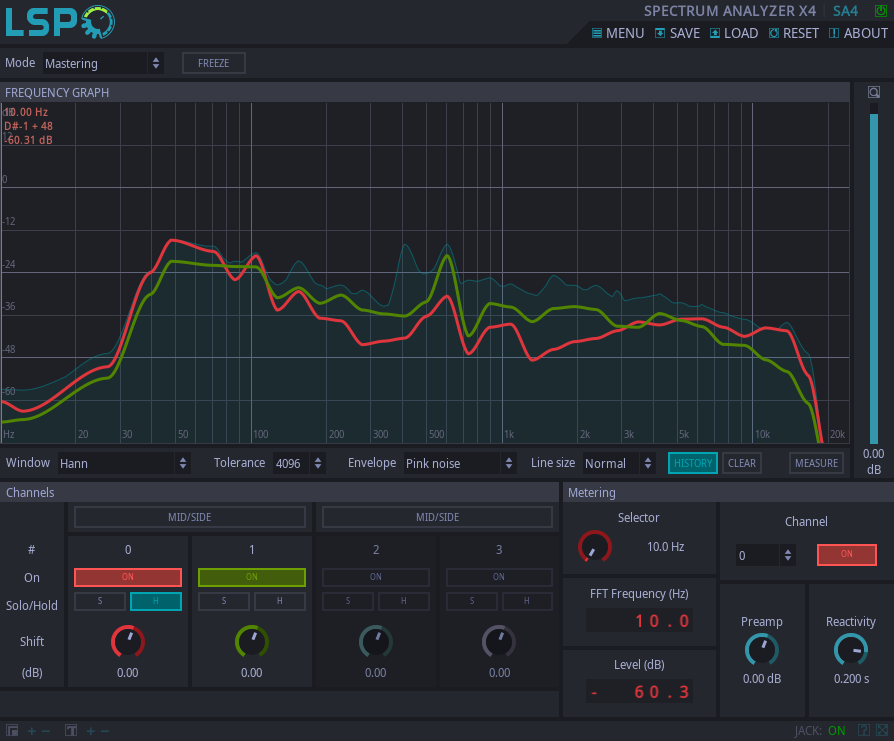Spectrum Analyzer x4

Detailed: LSP Spectrum Analyzer x4 (SA4)
Formats: CLAP, JACK, LADSPA, LV2, VST2, VST3
Categories: Analyser
Developer: Vladimir Sadovnikov
Description:
This plugin performs spectral analysis of 4 independent channels simultaneously. Stereo channels also are possible to analyze by utilizing special modes and selecting corresponding channels. It does not affect any changes to the input signal, so can be placed anywhere where the metering is needed.
Additional feature of Mid/Side analysis allows to transform stereo input pairs into Mid/Side and perform spectral analysis of Mid and Side parts instead of Left and Right ones.
Common controls:
- Bypass - bypass switch, when turned on (led indicator is shining), the plugin does not work.
- Mode - depending on operating modes, different analysis can be performed:
- Analyzer - performs analysis of 4 independent channels simultaneously.
- Analyzer Stereo - performs analysis of two selected audio channels.
- Mastering - performs less accurate but more demonstrative analysis of 4 independent channels simultaneously.
- Mastering Stereo - performs less accurate but more demonstrative analysis of two selected channels.
- Spectralizer - draws spectral analysis of single channel.
- Spectralizer Stereo - draws spectral analysis of two selected channels.
- Freeze - immediately freezes all frequency graphs.
- Linear frequency - enables linear scale of the frequency on the horizontal axis instead of logarithmic one.
- Inspect - enables band-pass filter applied to audio signal when moving vertical frequency slider on the graph.
- Inspect range - the frequency range in octaves of the band-pass filter.
- Spectrogram - the rendering mechanism of the spectrogram in the Spectralizer mode:
- Rainbow - each dot on a spectrogram changes it's color's hue component depending on the amplitude of the signal starting with Hue of the selected channel.
- Fog - each dot on a spectrogram changes it's transparency depending on the amplitude of the signal.
- Color - each dot on a spectrogram changes it's color's saturation component depending on the amplitude of the signal.
- Lightning - each dot changes it's solor's lightness component depending on the amplitude of the signal, the Hue is interpreted as a middle value of the possible value range.
- Lightness - each dot changes it's solor's lightness component depending on the amplitude of the signal, the Hue is interpreted as a maximum value of the possible value range.
- Channel(s) - numbers of channels currently displayed on the graph.
- Mid/Side - allows to switch selected channels from stereo analysis to the Mid/Side analysis.
- Measure - Additional button that enables horizontal measuring line.
- Log dots - the way how dots on the spectrogram are rendered. When button is down, logarithmic scale is used to translate amplitude into dot's color.
- Line size - the combo box that allows to change the thickness of the lines on the spectrum graph.
Channel controls:
- On - turns on the analysis of the channel.
- Solo - allows to individually inspect the corresponding channel.
- Hold - forces the frequency graph of the channel to freeze.
- Shift - allows to adjust the gain of the channel.
- Preamp - allows to adjust the overall gain of the analysis.
- Link - stereo link, allows to add signal to the input channel pair passed from the shared memory link.
- Channel - allows to select the channel for level metering.
- Mid/Side - allows to switch the channel pair (which consists of two near subsequent channels) to the Mid/Side analysis mode.
- Selector - allows to select the available frequency for level metering.
- Reactivity - the reactivity (smoothness) of the spectral analysis.
- Level - the level of the selected frequency.
- Window - the window applied to the audio data before processing.
- Tolerance - the number of points for the FFT (Fast Fourier Transform) analysis.
- Envelope - the envelope compensation of the signal.
- History - Show chart with maximum registered peak values among the full frequency range of all channels.
- Max - Show chart with maximum registered peak values among the full frequency range of selected channels.
- Clear - Clear charts with maximum retistered peak values among the full frequency range.
- Zoom - zoom fader, allows to adjust zoom on the frequency chart.
Meters:
- Frequency - the current frequency selected by Selector control.
- Level - the level of the selected Frequency for the channel specified by Channel control.































